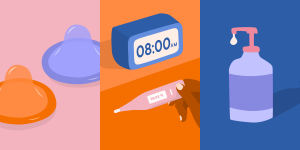Photos by Franz Grünewald
Skin and the cycle: how hormones affect your skin
Top things to know:
Your skin changes in response to hormones, like estrogen and testosterone
If you have oily-type skin, you may notice an increase in facial oil before and during your period
Acne outbreaks during the premenstrual and menstrual period are common
Your skin is one of your body's largest and most important organs. It forms a protective physical barrier, regulates your temperature, and provides a route for elimination for fluids like sweat and oils (1).
There is not a “standard normal” state for your skin, as it will change as you age and pass through different phases. Your skin can also change with the outside climate, or with sickness or ailments (12).
You may have noticed changes to your skin—particularly the skin of your face—starting around puberty. Your skin responds to many signals, including your hormones, through many receptors (3-6).
How hormones can cause oily skin
Many of the skin changes you may experience around puberty and later in life are due to small glands called sebaceous glands. These sebaceous glands produce and secrete an oily substance called sebum. Starting around puberty, sebaceous glands increase in size, and begin to secrete sebum, with the most sebum secreted between 15-35 years of age (7). The medical term for the condition of having oily skin is called seborrhea, and has different causes.
Sebaceous glands, like many other parts of the skin, have receptors which are influenced by sex hormones. These glands are affected most dramatically by androgens, which are male sex hormones like testosterone, but are present in both sexes (4,8,9). These androgens increase the production of sebum during puberty in both sexes (8,9). When there are more androgens binding to the receptors on the sebaceous glands, more sebum is produced. This can lead to noticeably oilier skin, and may progress to acne.
Sebum production may change throughout the menstrual cycle. The impact that estrogen has on sebum production is still unclear. Estrogen has been demonstrated to suppress levels of sebum production and gland activation, particularly at high doses (4,9-12). But how the natural fluctuations of estrogen throughout the menstrual cycle affect skin is harder to understand. In one study of women with oily skin, increases in sebum production occurred during the week preceding menstruation and also during the week of menstruation (13). The week with the lowest amount of sebum production occurred during the second week of the menstrual cycle (13). In women without oily-type skin, no significant changes in sebum production were measured (13). Since hormonal levels were not measured in this study, the researchers were unable to say if the changes in oiliness of the skin were conclusively due to changes in hormone levels (13).
Many other factors play a role in sebum levels: genetics, seasonal changes, excessive sun exposure, and overuse or misuse of skin care products all can affect the oiliness of your skin (2,4).
Going deeper on estrogen: how it affects skin health
Even though it is still unclear how much estrogen affects sebaceous glands, estrogen plays a prominent role in overall skin health. Estrogen is associated with increased collagen production, skin thickness, skin hydration, wound healing, and improved barrier function (5,6). One study found that 2 out 5 women self-report more sensitive skin around the time of menstruation, which researchers suspect could be due to low levels of estrogen during this phase (14).
Many of the ways that researchers study the impact of estrogen on skin is by comparing premenopausal women (who have higher levels of estrogen) to post-menopausal women (who have lower levels of estrogen). In the study referenced above, a third of postmenopausal and perimenopausal women also noted that increased skin sensitivity after menopause — the time when estrogen levels decrease (14).
Acne and the menstrual cycle
When high levels of androgens promote excess sebum production, the sebum can combine with dead skin cells from within the pore, causing a blockage (8,9). This blockage of the pore can trap all the excess sebum being produced and manifest as acne (15,9,10). These sebum filled pores are the ideal place for bacteria to live—particularly P. acnes, which loves to colonize these pores, and further worsen and causes inflammatory acne (15,16).
Acne (acne vulgaris) is one of the most frequently reported skin ailments connected to your cycle (4,8). Period-related hormonal breakouts are very common in the perimenstrual phase (the 10 days before your period, plus days of bleeding) (4,8).
The reasons for hormonal acne are still not clear, but there are some theories. Some researchers think that before the period starts, there is not enough estrogen to promote its “anti-sebum” effects (4,9-12). Without high estrogen, androgens increase sebum production, which leads to increased pore clogging and a habitable environment for P. acnes. Other theories suggest that hormonal acne might be caused by a deficiency or imbalance of progesterone to estrogen ratios (4). More research is needed.
Women and people with cycles who have higher levels of androgens, such as people with polycystic ovarian syndrome (PCOS), are more likely to have acne, as well as excess hair growth and female pattern hair loss (9). Trans men may also notice an increase in acne lesions during the first year of taking testosterone, but this should decrease after long term testosterone use (17).
Some people see a reduction in acne breakouts on hormonal birth control, which is why oral contraceptives are sometimes used to treat acne. Within the combined contraceptive pill, synthetic estrogen is present in doses which suppress ovulation. When ovulation doesn’t occur, ovarian androgens are not produced (9).
Not all acne is related to menstrual or hormonal cycling. Acne affects people of all sexes and all ages (18). Genetics, diet, and bouts of stress can also influence acne, but more research is needed here (9,19).
Treating acne can help improve self-esteem and quality of life (20). Acne outbreaks may not be a question of hygiene, but of how carefully you treat your skin around days of increased skin sensitivity.
Sweat and menstrual cycle phases
Your body’s ability to sweat changes throughout your cycle as well. Your basal body temperature increases in the luteal phase (second half of your cycle). Researchers have noticed that women in their luteal phase show an increase in sweat produced when exposed to warmer temperatures, in comparison to when they were in their follicular phase (the first half of their menstrual cycle) (21). This increase in sweating was noticed not just on the face, but across the whole body (21). If you do notice changes in sweating throughout your menstrual cycle, track them with custom tags in Clue.
Dry skin and the menstrual cycle
Having skin that’s drier than you’d like is very common, especially during cold seasons or dry climates. Dry skin is also influenced by genetics and may become more prevalent with age (22). Dermatitis, psoriasis, and other skin conditions or diseases may worsen during the premenstrual phase (4,5,23-25).
Use Clue to track your skin changes throughout your cycle
Your skin may change in response to hormonal variations occurring throughout your cycle. You may notice differences in acne outbreaks, skin hydration, elasticity, and wound healing ability at different times in your cycle.
Tracking skin changes on Clue will allow you to notice any patterns that may occur with your cycle or other life factors (like sleep and stress). Tracking may also help you choose effective strategies for managing skin problems like acne.





